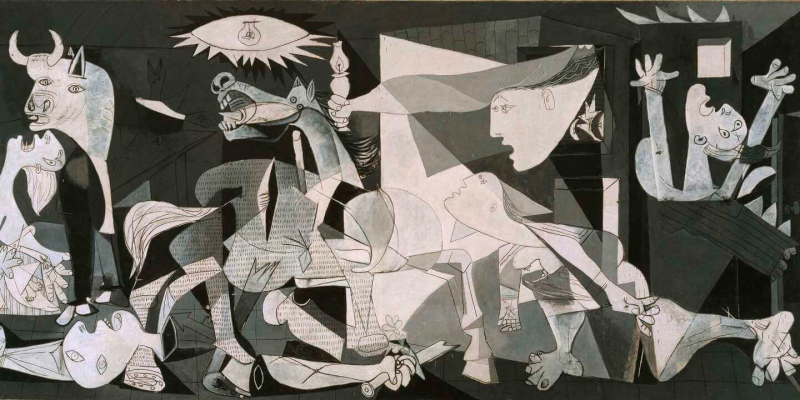Guernica
Pablo Picasso's "Guernica" is a profound statement on the atrocities of war. It was created in response to the 1937 bombing of Guernica, a Basque Country town in Spain. The painting is an artistic outcry against the horrors inflicted by the Spanish army and its allies. This 3.49 x 7.76-meter oil-on-canvas, housed in the Museo Reina Sofía in Madrid, is one of Picasso's most politically charged works.
"Guernica" is a raw portrayal of pain and chaos. Picasso, who usually kept art separate from politics, was deeply moved by the attack. So he depicted the agony of the bombing's victims. The painting's monochromatic scheme of grey, white, and black adds to its somber mood. It conveys the bleakness of war and the despair of those caught in its wake.
The prominent figures in "Guernica" are women. Each represents different aspects of pain and suffering. A woman with a dead child wails in agony, symbolizing the ultimate loss. Another tries to flee, while one more stands shocked with her arms raised. The use of female figures as central characters underscores the universal impact of war. That affects the most vulnerable and innocent.
Picasso was known for his symbolic imagery, and "Guernica" is no exception. The bull and the horse, central figures in the painting, have sparked much debate over their meanings. Picasso himself refrained from providing clear interpretations. It emphasizes that the viewer's understanding is as valid as any. This open-ended symbolism invites continuous discussion and interpretation. That makes "Guernica" a breathing piece of history and emotion.
Beyond its artistic value, "Guernica" has played a significant role in political discourse. Its antifascist message made it a target of criticism by supporters of fascism. Yet it also became an emblem for peace and anti-war movements. Notably, a tapestry reproduction of "Guernica" at the United Nations was famously covered during a speech advocating for the Iraq War.
"Guernica" was Picasso's way of responding to the tragedy, a visual journalist capturing the moment's raw emotion and transforming it into a timeless call for peace. His choice to work in greyscale was deliberate. It strips the scene of the vibrancy of life and underscores the darkness of war.
Key Takeaways:
- Title: Guernica
- Artist: Pablo Picasso
- Year: 1937
- Medium: Oil on canvas
- Size: 3.49 m x 7.76 m (11 ft 5 in x 25 ft 6 in)
- Location: Museo Reina Sofía, Madrid, Spain













